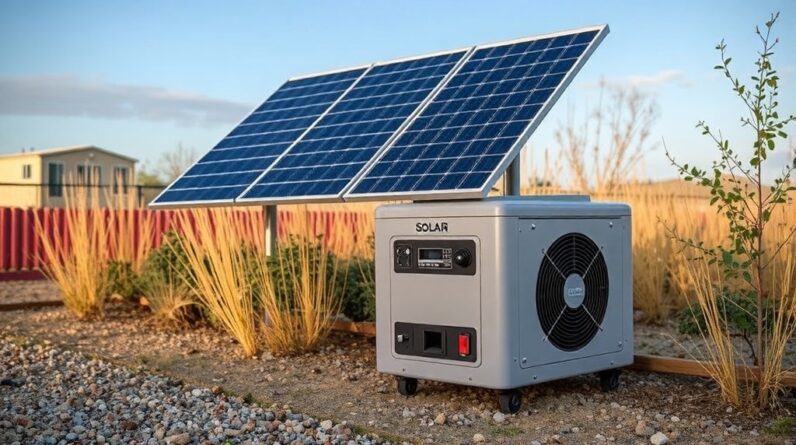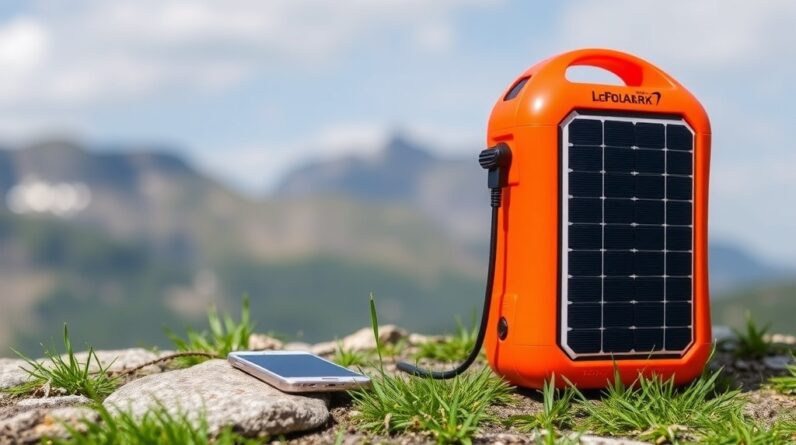
This post contains Amazon affiliate links.
Key Takeaways
- Solar power stations provide silent, emission-free emergency power that apartment and condo residents can safely use indoors without carbon monoxide risks or noise violations.
- Traditional generators require 20-foot clearance from buildings and violate most apartment building policies, making solar power stations the only viable backup power option for small spaces.
- Portable solar systems can generate between 0.3-2 kWh daily depending on conditions, enough to power essential devices like refrigerators, lights, and communication equipment during outages.
- Advanced battery management systems and zero-emission operation make solar power stations apartment-safe, unlike gas generators that pose deadly carbon monoxide threats.
Silent Power Solution for Small-Space Emergency Preparedness
When power outages strike apartment buildings and condominiums, residents face a critical challenge: how to maintain essential electricity without access to traditional backup solutions. Unlike homeowners with yards and garages, apartment dwellers must work within strict building policies, noise ordinances, and safety restrictions that make conventional generators impossible to use.
Solar power stations provide the ideal emergency power solution for small living spaces, delivering reliable electricity without the dangers, noise, or space requirements of gas-powered alternatives. These compact systems combine lithium battery storage with portable solar panels, creating a complete backup power solution that works safely indoors. Solar Emergency Charger specializes in helping apartment and condo residents find the right solar power station setup for their specific space and power needs.
The technology has evolved dramatically, with modern portable solar systems capable of generating 0.3 to 2 kWh daily from apartment-friendly setups. This capacity proves sufficient for powering essential appliances like refrigerators, lighting systems, communication devices, and small electronics during extended outages.
Why Traditional Generators Fail Apartment Dwellers
Carbon Monoxide Safety Restrictions – CPSC Recommends 20-Foot Distance
The Consumer Product Safety Commission recommends that gas generators operate at least 20 feet away from any building structure, with exhaust directed away from windows, doors, and air conditioning units. This requirement immediately disqualifies traditional generators for apartment use, as most residents lack access to outdoor space that meets these safety standards.
Carbon monoxide poisoning from improperly positioned generators kills dozens of Americans annually and hospitalizes hundreds more. The colorless, odorless gas can seep through walls, windows, and ventilation systems, making indoor or near-building generator use potentially fatal for entire apartment buildings.
Noise Ordinance Violations
Most municipal noise ordinances restrict sound levels to 55-65 decibels during daytime hours and 45-55 decibels at night. Traditional generators typically operate at 65-75 decibels, creating immediate violations that can result in fines and forced shutdown during critical power outages.
Even “quiet” inverter generators commonly operate above 58 decibels at quarter load, making them unsuitable for dense residential environments where neighbors live mere feet away through shared walls.
Space and Storage Limitations
Gas generators require dedicated storage space for the unit itself, plus secure fuel storage that meets fire safety codes. Most apartment leases explicitly prohibit storing gasoline or other flammable liquids on the premises, making generator ownership logistically impossible.
Additionally, generators need regular maintenance, testing, and seasonal preparation that requires workspace and ventilation – amenities unavailable to most apartment residents.
Building Policy Prohibitions
Homeowners associations, condo boards, and apartment management companies typically prohibit generator use through explicit lease clauses or building policies. These restrictions stem from liability concerns, noise complaints, fire hazards, and insurance requirements that make generators incompatible with multi-unit residential buildings.
Solar Power Station Essentials for Small Spaces
Balcony Solar Panel Setup
Modern portable solar panels like the EcoFlow 220W Bifacial model are specifically designed for apartment balcony installations. These lightweight panels fold flat for storage and can be positioned to capture optimal sunlight throughout the day without permanent mounting or building modifications.
Balcony solar setups can effectively reduce electricity bills while generating clean power for daily needs including lights, electronics, and small appliances. The bifacial design captures reflected light from balcony surfaces, increasing efficiency even in partially shaded conditions common in apartment buildings.
Indoor-Safe Battery Storage
Lithium iron phosphate (LiFePO4) batteries used in quality solar power stations operate safely indoors without ventilation requirements, unlike lead-acid batteries that emit dangerous gases. These systems can be stored in closets, under beds, or in any interior space without fire or health risks.
Models like the Anker 521 Portable Power Station weigh just 8.2 pounds with 256Wh capacity, making them easily portable while providing enough power for essential devices during short-term outages.
Window-Friendly Charging Options – Reduced Efficiency but Still Functional
When balcony access isn’t available, portable solar panels can charge power stations through window placement, albeit at reduced efficiency. South-facing windows provide the best results, while even north-facing windows can generate some power during peak sun hours.
This flexibility allows renters to experiment with solar charging without permanent installations or landlord approval, making it an accessible entry point for apartment solar power.
Real-World Power Capacity for Apartment Living
Daily Energy Generation (1-2 kWh from 400W Systems)
A typical 400W portable solar panel system can generate 1-2 kWh daily under good conditions, providing substantial power for apartment emergency needs. This output varies based on sunlight hours, panel positioning, and seasonal conditions, but remains sufficient for essential device operation.
During winter months or cloudy conditions, generation may drop to 0.3-0.8 kWh daily, emphasizing the importance of battery storage capacity and energy-efficient appliance selection during extended outages.
Specific Appliance Runtime Examples – Refrigerator to Space Heater
A 1000 watt-hour power station can theoretically operate a standard refrigerator (700W) for approximately 1.4 hours, though actual runtime may vary based on the refrigerator’s cycling and the power station’s efficiency. LED lighting (50W total) could run for 20 hours, or charge smartphones and laptops multiple times. For heating, a small space heater (500W) could run for 2 hours on the same capacity.
Strategic power management allows apartment residents to prioritize critical needs: maintaining refrigerated medications and food, powering communication devices, and providing emergency lighting during multi-day outages.
Safety Features That Make Indoor Use Possible
Battery Management Systems – Voltage, Current, Temperature Monitoring
Advanced Battery Management Systems (BMS) continuously monitor voltage, current, and temperature to prevent dangerous conditions like overcharging, over-discharging, and thermal runaway. These systems automatically shut down operations if parameters exceed safe limits, eliminating fire and explosion risks.
Quality power stations include multiple protection layers: short circuit protection, overcurrent protection, and temperature cutoffs that make indoor operation as safe as any household electronic device.
Zero-Emission Operation – Safe for Indoor Use
Solar power stations produce no emissions, exhaust, or dangerous gases during operation, making them safe for indoor use in apartments, condos, and other enclosed spaces. These systems have been verified as safe for residential indoor use through extensive testing and certification processes.
Unlike generators that produce carbon monoxide, nitrogen oxides, and other toxic compounds, solar power stations operate silently and cleanly, posing no respiratory or health risks to residents or neighbors.
Overcharge Protection – Charge Controllers and BMS Integration
Integrated charge controllers work with battery management systems to prevent overcharging from solar panels, ensuring safe operation even during peak sun conditions. These systems automatically regulate charging current and voltage, preventing battery damage and safety hazards.
Modern power stations like the Anker Solix F3800 can expand with up to six additional batteries, each with a capacity of 3840Wh, while maintaining safe charging protocols, allowing scalable power solutions for larger apartments or extended outage periods.
Alternative Solar Options for Renters
Community Solar Projects – DOE-Supported Shared Arrays
Community solar programs allow apartment residents to subscribe to shared solar arrays located in optimal sun exposure areas, receiving credits on their electric bills without installing panels. The Department of Energy supports these initiatives as accessible renewable energy solutions for renters and urban residents.
Subscribers typically pay for a portion of electricity produced by the community array and receive credits on their electric bills. The billing structure may vary depending on the program, with some receiving separate bills while others see credits applied directly to their utility bill.
Green Energy Provider Programs – Supporting Renewable Growth
In deregulated energy markets, apartment residents can choose green energy providers that supply electricity from renewable sources including solar, wind, and hydroelectric generation. These programs allow renters to support renewable energy growth without personal solar installations.
Even in regulated markets, many utility companies provide green power product options that source electricity from renewable energy facilities, providing environmental benefits and often stable pricing for apartment residents.
Solar Power Stations Deliver Reliable Emergency Power Without Compromise
For apartment and condo residents facing the reality of power outages, solar power stations represent the only viable emergency power solution that meets safety requirements, building policies, and space constraints. These systems provide silent, emission-free operation that can safely run indoors while delivering enough power to maintain essential appliances and devices.
The combination of portable solar panels and lithium battery storage creates a flexible, scalable power solution that grows with resident needs and moves with them to new locations. With daily generation capacity of 1-2 kWh from apartment-friendly setups, these systems provide meaningful emergency preparedness without the dangers and restrictions of traditional generators.
Advanced safety features including battery management systems, overcharge protection, and zero-emission operation make solar power stations as safe as any household appliance, while delivering the peace of mind that comes with reliable backup power during critical situations.
Find complete solar power station solutions designed specifically for apartment and condo living at Solar Emergency Charger, where expert guidance helps small-space residents achieve energy independence safely and effectively.
This post contains Amazon affiliate links.






